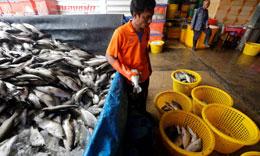Sustainable seafood farms can help Asia’s oceans

By Mata Press Service
Southeast Asia has one of the most diverse marine ecosystems in the world, but overfishing and destructive fishing threaten its sustained existence.
Across the region, 64 percent of the fisheries’ resource base is at a medium to high risk from overfishing, with Cambodia and the Philippines among the most heavily affected, a report by the Asia Foundation said.
Meanwhile, the United Nations reports that in Asia, there will be no fish stocks for commercial fishing by 2048.
“If trends continue, there will be no "exploitable fish stocks" for commercial fishing by 2048. Around that same, the region will lose 45 per cent of its biodiversity and about 90 per cent of its crucial corals, if nothing changes,” said Asia co-chair Sonali Seneratna Sellamuttu, a senior researcher at the International Water Management Institute.
"All major ecosystems are threatened in the region," she said.
The experts and scientists are recommending expansion of sustainable aquaculture within the region to help reduce pressures on natural fish stock.
“Sea-farming can be especially helpful to small-scale fishery communities looking to shift into a more stable (and sustainable) livelihood, while expansion of freshwater aquaculture in inland farming communities can concurrently increase fish supplies sustainably,” the Asia Foundation said after a recent fisheries summit in Bangkok which was attended by over 80 experts—diplomats, scientists, activists, entrepreneurs, and civil society organizations— from over 20 countries.
There is also a significant lack of science-based knowledge about the region’s marine ecosystems to inform policies that would lead to the establishment of sound models for fisheries management, as well as insufficient focus on cultivating alternatives to wild catch fisheries, such as sea-farming and inland freshwater aquaculture.
As competition for remaining fish stocks grows fiercer, some experts warn that the region’s entire fisheries industry will soon collapse. Estimates suggest that in order to prevent this, all countries fishing in the region would need to cease all destructive fishing practices and reduce harvest by nearly 50 percent.
In Asia, in recognition of the potential effects of diminishing marine-capture fisheries, many countries have turned to aquaculture as a means to reduce overfishing while increasing fish supply, providing employment, and generating foreign income.
Currently, Asian countries account for the nearly 90 percent of global aquaculture production. In 2016, China produced 51.4 million tonnes of farmed fish, accounting for more than 60 percent of global fish production from aquaculture. Vietnam, Indonesia, and the Philippines are major farmed-fish producers as well. Owing to growing concerns over the safety of the farmed fishery products and environmental impacts of the intensive freshwater and coastal aquaculture, China has made expanding mariculture a priority of the government’s 13th Five-Year Fisheries Development Plan.
A recent study entitled Mapping the global potential for marine aquaculture published in nature.com said marine aquaculture presents an opportunity for increasing seafood production in the face of growing demand for marine protein and limited scope for expanding wild fishery harvests.
“Even after applying substantial constraints based on existing ocean uses and limitations, we find vast areas in nearly every coastal country that are suitable for aquaculture.”
“We suggest that the vast amount of space suitable for marine aquaculture presents an opportunity for countries to develop aquaculture in a way that aligns with their economic, environmental and social objectives,” the study said.
Given the status of fish stocks, the only way to meet this rising demand will be through aquaculture, states Zhang Hongzhou, a Research Fellow at the China Program at the Nanyang Technological University, Singapore.
“Considering the fact that aquaculture in the South China Sea region is becoming increasingly intensified, sustainable fish farming in other regions such as United States, Africa, and Latin America, should be promoted to increase the global fish supply, he said in his study.
According to the Global Aquaculture Alliance aquaculture production is projected to grow from 47.2 million metric tons in 2006 to 93.6 million metric tons by 2030, while wild fisheries production is expected to decline from 64.5 million metric tons to 58.2 million metric tons during that same time.
To feed the world’s growing population, aquaculture has to deliver an additional 46.4 million metric tons to meet the world’s seafood needs, the organization said.
How Canada can help save Asia’s oceans
The global demand for seafood is steadily increasing. Population growth, rising per capita incomes, and urbanization are fueling a 7 - 9% increase in demand each year, says the Canadian Aquaculture Industry Alliance (CAIA)
According to Food and Agriculture Organization of the United Nations, aquaculture will need to supply 2/3 of the world’s seafood requirements by 2030. Without aquaculture, the world will face a seafood shortage of 50-80 million tonnes by 2030.
Few countries can match Canada’s natural advantages when it comes to aquaculture—an enormous coastal geography, an abundance of cold, clean water, a favourable climate, a rich marine and fishery tradition, and established trade routes to the United States, Asia, and Europe.
However, Canada has yet to fully capitalize on its opportunity to become a global aquaculture leader, said CAIA. Canada’s aquaculture production has shown little growth since 2000. Through a comprehensive analysis of Canadian aquaculture, CAIA determined that the principal factor constraining the growth of the aquaculture sector was Canada’s complicated and inefficient aquaculture regulatory system.
The Alliance projects that with the proposed legislative, regulatory and policy reforms, by 2024 Canadian aquaculture could:
increase production to over 378,000 tonnes per year;
generate more than $6.35 billion in economic activity per year;
increase GDP to $2.5 billion per year;
employ more than 32,500 Canadians;
increase output by 120%, but increase water acreage by only 38%;
occupy only 1.35% of the total area biophysically suitable for aquaculture in Canada – a much, much smaller footprint than in other countries.









